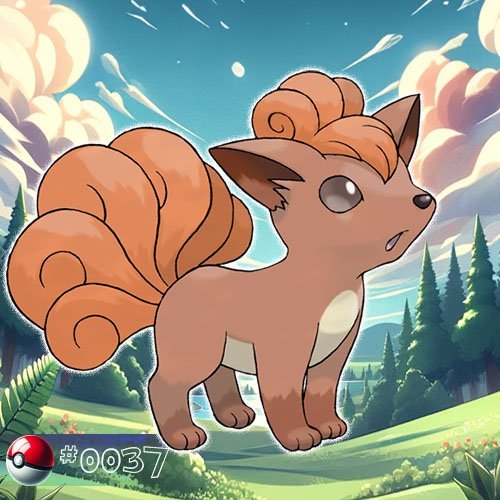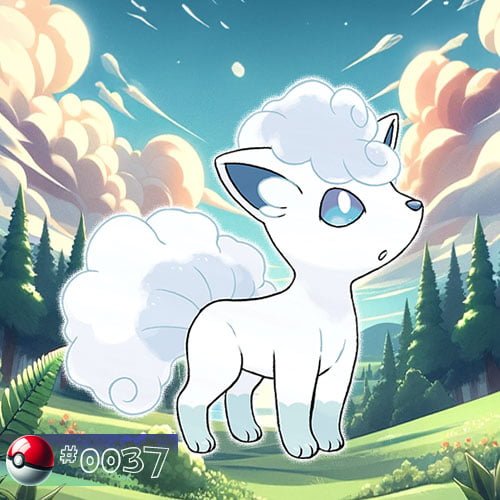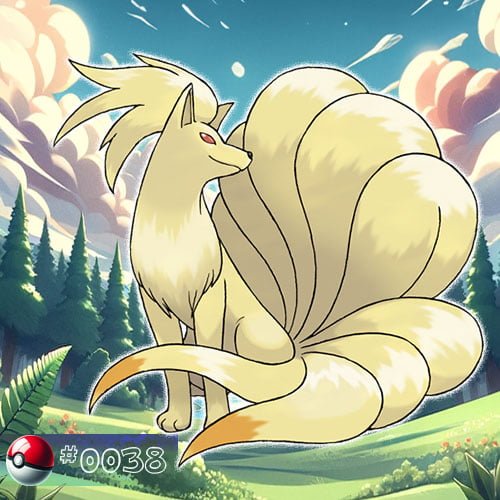Vulpix
Vulpix is a Fire-type Pokémon recognized for its beautiful, orange fur and is often associated with a mystical, enchanting presence in the Pokémon world.

| National Pokedex No: 0037 |
| Type: |
| Category: Fox Pokémon |
| Height: 0.6 m (2′00″) |
| Weight : 9.9 kg (21.8 lbs) |
| Gender: 25% ♂, 75% ♀ |
| Abilities/Hidden abilities:Flash Fire/Drought |
Biology
Physical Characteristics
Vulpix is a small, quadrupedal Pokémon with fox-like characteristics.
Vulpix is covered in beautiful, orange fur, which is soft and fluffy. It has large, expressive blue eyes that give it an innocent and cute look. The fur on its six tails is especially thick and 0luxurious.
Vulpix has six orange tails that are curled at the end. These tails are a key aspect of its beauty and elegance. The number of tails signifies its age and power, with each tail growing as it evolves.
It has pointed ears that add to its fox-like appearance. The ears are covered in the same orange fur as its body. The facial features include a small, triangular black nose and a mouth with sharp teeth. Its eyes are wide and convey a sense of intelligence and emotion.
Vulpix is relatively small in size, fitting the profile of a cute and charming Pokémon. Its compact form makes it easy to carry and care for as a companion. Vulpix has four short legs, each ending in a paw with three claws. The paws are designed for mobility and agility.
Overall, Vulpix’s physical characteristics contribute to its enchanting and graceful appearance, making it a beloved Pokémon among trainers and fans alike.
Alolan form
Alolan Vulpix, an Ice type Pokémon and a regional variant of Vulpix found in the Alola region, has distinct physical characteristics that set it apart from its Kantonian counterpart.
Alolan Vulpix has snowy white fur instead of the reddish-brown color seen in the Kantonian Vulpix. This fur helps it blend into its snowy habitat. Unlike the dark brown eyes of the Kantonian Vulpix, the Alolan Vulpix has striking blue eyes, resembling ice.
It has six tails, similar to the Kantonian Vulpix, but these tails are tipped with a light blue color, giving the appearance of ice or snow at the tips.

The insides of its ears and its paw pads are light blue, matching the tips of its tails and further enhancing its icy appearance.
Alolan Vulpix is small and fox-like, maintaining a petite and delicate frame that contributes to its cute and elegant look. Often depicted with a slight frosty aura or snowflakes around it, emphasizing its Ice type.
These characteristics make Alolan Vulpix well-adapted to cold, snowy environments and give it a distinct, ethereal beauty.
Behaviour
Vulpix, known for its fox-like appearance, exhibits distinct behaviors that add to its charm.
Vulpix is naturally cautious, often assessing its surroundings before making a move. Its cautiousness contributes to its ability to avoid potential dangers. Vulpix is known to form strong bonds with its trainers, displaying loyalty and affection. In the wild, Vulpix can be social with its fellow Pokémon, especially within its evolutionary line.
Vulpix is considered a clever and intelligent Pokémon, using its wits to navigate various situations. Its intelligence can be observed in battles, where it employs strategic moves.
Vulpix is highly sensitive to temperature changes, particularly favoring colder environments. Its adaptation to cold climates is reflected in its Ice-type Alolan form.
Young Vulpix, and even older individuals, exhibit playful behavior. They may engage in games, frolic, and use their agility to navigate their surroundings. While Vulpix doesn’t vocalize like some Pokémon, it communicates through body language and expressions. Trainers often develop a deep understanding of their Vulpix’s feelings.
Vulpix, like many Pokémon, exhibits nesting instincts, especially during the breeding season. It may create nests or seek sheltered places for resting and sleeping. Vulpix can display independence, particularly in situations where it needs to fend for itself. This trait aids its survival in the wild.
Trainers find Vulpix to be adaptable to various training methods, thanks to its clever nature. It can learn and execute a variety of moves in battles.
Understanding and appreciating Vulpix’s behavior enhances the bond between trainers and this captivating Pokémon, making it a delightful companion in the Pokémon world.
Evolution
Vulpix, a Fire-type Pokémon, undergoes a notable evolution process. Here’s a detailed overview of Vulpix’s evolution.
Vulpix is the base form of this Pokémon species. It’s a small, fox-like Pokémon with orange fur, six orange tails, and a cream-colored underbelly.
The primary evolution of Vulpix is triggered by the use of a specific evolutionary item known as a Fire Stone. When a Fire Stone is applied to Vulpix, it initiates the evolution process. The result of Vulpix’s evolution with a Fire Stone is Ninetales. Ninetales is an elegant and mystical Pokémon with nine long, fluffy tails.Its fur becomes more vibrant, and it gains enhanced mystical abilities.
Alolan Form – Alolan Vulpix
In the Alola region, Vulpix takes on a regional variant known as Alolan Vulpix. Alolan Vulpix is an Ice-type Pokémon, adapting to the colder climate of Alola. It has blue fur, icy blue eyes, and a generally more frosty appearance.
Alolan Vulpix evolves into Alolan Ninetales when exposed to an Ice Stone. Alolan Ninetales retains the Ice typing and features a majestic, ethereal appearance with longer tails.
Vulpix’s evolution, influenced by environmental factors and specific evolutionary stones, results in diverse forms with distinct types and characteristics. Trainers have the option to choose between the classic Kantonian form or the icy Alolan forms.
Appearances
Anime Main Appearances
Brock’s Vulpix
Brock‘s Vulpix was given to him as a gift by a Pokémon Breeder named Suzy in the episode titled “Pokémon Fashion Flash.” Brock’s Vulpix serves as a loyal and reliable companion in Brock’s team. But in the episode ”Beauty and the Breeder”, he returned it back to Suzy.
Snowy (Alolan Vulpix)
Snowy is of the Alolan Vulpix variant, which is a regional form of the traditional Vulpix found in the Alola region. Lillie’s Alolan Vulpix was given to her by her brother, Gladion, as an Egg. The Egg hatches into Snowy ( ”Racing to a Big Event!”) during the course of the anime.
Snowy plays a significant role in Lillie’s character development. Lillie is initially fearful of touching or being close to Pokémon. But she caught him in the episode ”Getting to Know You!’.
Other appearences
In ”Mewtwo Strikes Back”, a cloned Vulpix from Brock participated in the battle between originals and clones. Macy’s Vulpix, not used in battles, was briefly captured by Team Rocket but saved by Ash. May’s Egg hatched into a Vulpix. Samson Oak’s Vulpix, hatched in Alola, reappeared in subsequent adventures. Cerah’s Alolan Vulpix, seen in a flashback, evolved into Alolan Ninetales in the episode ”Getting a Jump on the Competition!”.
Anime Minor Appearances
In various Pokémon episodes and movies, Vulpix made numerous appearances. These include being controlled by Cassidy and Butch in ”Pikachu Re-Volts”, a flashback in ”Wherefore Art Thou, Pokémon?”, and participating in ”Pikachu’s Rescue Adventure”.
Additionally, Vulpix featured in ”Pokémon Heroes: Latios & Latias” under an elderly woman’s ownership, various contests and competitions, as well as joining the celebration in ”Securing the Future”.
A Trainer’s Vulpix was seen in these episodes:
- ”You’re a Star, Larvitar!”
- ” Crystal-Clear Sleuthing!”
- ” I Choose You!”
- ” Mimikyu Unmasked!”
- ” The Power of Us” (six of the appeared)
- ” Legend? Go! Friends? Go!” (in a video hologram)
- ”Caring for a Mystery!” (in the Vermilion City Pokémon Center)
- ”Betrayed, Bothered, and Beleaguered!”
- ”Trade, Borrow, and Steal!”
- ”Making Battles in the Sand!”
- ”Secrets of the Jungle”
- ”A Rollicking Roll…”
- ” For Sure! ‘Cause Sprigatito’s with Me!” (Nurse Joy took care of him)
A Coordinator’s Vulpix appeared in the episode ”The Saffron Con” and ”What I Did for Love!”.
Its versatile roles showcase the diversity of encounters across the Pokémon world.
Manga Appearances
Magical Pokémon Journey
Kiaraway is a Pokémon Trainer from the manga series Magical Pokémon Journey, specialized in collecting Fire-type Pokémon. He possesses a female Vulpix, one of his frequently used Pokémon. She made her debut alongside Cyndaquil in the episode “Vulpix and Cyndaquil”. She shares a close friendship with Coconut.
Pokémon Adventures
Yellov arc – In the episode ” Hitmonlee, Baby! (One More Time)” Bill’s Vulvis made its first appearence. Vulpix was a guardian of his house.
Gold, Silver & Crystal arc – Bill’s Vulpix made a return at the Pokémon Association during Bill’s discussion on Gym Leaders in “Sunkern Treasure.” In the episode “Slugging It Out With Slugma,” it appeared once more, causing disruption alongside Bill’s Exeggcute during a conversation with Professor Oak.
Ruby & Sapphire arc – Flannery’s Vulpix first appeared in “Bravo, Vibrava.” In the battle against Shelly’s Ludicolo, it fought valiantly. Despite being defeated, Vulpix cleverly disabled Ludicolo’s Nature Power with a strategic Grudge before fainting.
Sun, Moon, Ultra Sun & Ultra Moon arc – In the episode ”Shock!! Father in the Pendant!”, on Mount Lanakila, appeared Multiple Alolan Vulpix for the first time.
Vulpix also appeared in these Pokémon manga:
Pokémon anime novelization series– in the episode ”Race to Danger” (Windy’s Vulpix)
Pokémon Pocket Monsters – in the episode ”Which One is the Real Clefairy!?”.
Pokémon Battle Frontier – appeares as a first Pokémon owned by Enta, the main character of Pokémon Battle Frontier manga.
Pokémon Gotta Catch ‘Em All – in the twenty ninth chapter – GDZ29 (evolves into Ninetales).
Pokémon Zensho – in the fourth chapter of the Pokémon Zensho manga – PZ05.
Game data
Stats
Location
| Game version | Location |
|---|---|
| Pokémon Red | Trade |
| Pokémon Blue | Routes 7 and 8, Pokémon Mansion |
| Pokémon Yellow | Celadon City |
| Pokémon Gold | Trade |
| Pokémon Silver | Routes 7, 8, 36, and 37 |
| Pokémon Crystal | Trade |
| Pokémon Ruby and Pokémon Sapphire | Mt. Pyre |
| Pokémon FireRed | Trade |
| Pokémon LeafGreen | Routes 7 and 8, Pokémon Mansion |
| Pokémon Emerald | Mt. Pyre |
| Pokémon Colosseum | Trade |
| Pokémon XD | ONBS |
| Pokémon Diamond and Pokémon Pearl | Routes 209 and 214 |
| Pokémon Platinum | Routes 209 and 214 |
| Pokémon HeartGold | Trade |
| Pokémon SoulSilver | Routes 7, 8, 36, 37, and 48 |
| Pokémon Black and Pokémon White | Abundant Shrine |
| Pokémon Black 2 and Pokémon White 2 | Abundant Shrine |
| Pokémon X and Pokémon Y | Breed Ninetales |
| Pokémon Omega Ruby and Pokémon Alpha Sapphire | Mt. Pyre, Mirage Spots |
| Pokémon Sun | Tapu Village, Mount Lanakila (Alolan Form), Pokémon Bank (Kantonian Form) |
| Pokémon Moon | Pokémon Bank (Trade) |
| Pokémon Ultra Sun | Tapu Village, Mount Lanakila (Alolan Form), Pokémon Bank (Kantonian Form) |
| Pokémon Ultra Moon | Pokémon Bank (Trade) |
| Pokémon: Let's Go, Pikachu! | Trade |
| Pokémon: Let's Go, Eevee! | Route 5, 6, 7 and 8, Celadon City |
| Pokémon Sword | Route 3, Rolling Fields, South Lake Miloch, East Lake Axewell, Axew's Eye, Dappled Grove, West Lake Axewell, Giant's Seat, North Lake Miloch, Watchtower Ruins |
| Pokémon Shield | Dusty Bowl, Hammerlocke Hills |
| Pokémon Brilliant Diamond | Trade |
| Pokémon Shining Pearl | Spacious Cave, Volcanic Cave, Sandsear Cave, Typhlo Cavern |
| Legends Arceus | Veilstone Cape |
| Pokémon Scarlet and Pokémon Violet | Trade |
Vulpix's origin name
The name “Vulpix” is derived from a combination of the words “vulpine,” indicating a fox-like nature, and “six,” likely referencing the Pokémon’s distinctive feature of having six tails. This nomenclature is consistent in English, German, and Spanish.
In Japanese, its name is “Rokon” (ロコン), originating from “rokku” (六), meaning six, and possibly “kitsune” (狐), signifying fox.
In French, it is called “Goupix,” a fusion of “goupil” (fox) and “six.”
In Korean, Vulpix is known as “Yeondu” (여우드), incorporating “yeou” (여우), meaning fox, and perhaps “du” (두), meaning two.
In Chinese (Mandarin), it is named “Lìyǎn” (六尾狐), translating to “Six-Tailed Fox.”
The Pokémon’s name remains consistent in various languages, reflecting its fox-like appearance and the characteristic six tails. These diverse names showcase the linguistic creativity and cultural nuances embedded in Pokémon naming conventions across different regions.



